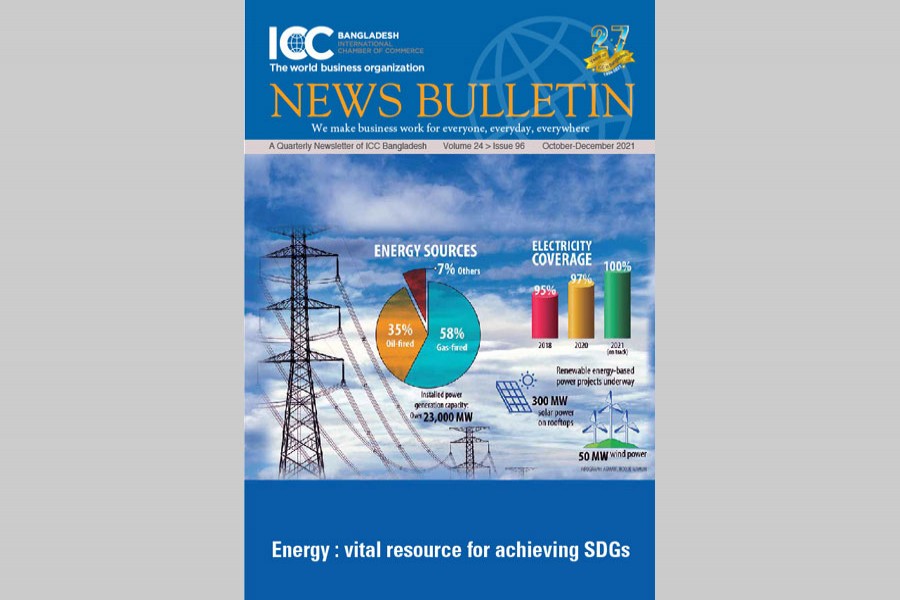Bangladesh has an impressive track record of growth and poverty reduction. It has been among the fastest-growing economies in the world over the past decade, supported by a demographic dividend, strong ready-made garment (RMG) exports, and stable macroeconomic conditions.
Continued recovery in exports and consumption will help the growth rate pick up to 6.4 per cent in FY22, according to a recent World Bank review on Bangladesh, said the editorial of the current News Bulletin (Oct-Dec’ 2021 issue) of International Chamber of Commerce-Bangladesh (ICCB) released on Wednesday.
Bangladesh, being one of the poorest nations at birth in 1971, with the tenth lowest per capita GDP in the world has reached lower-middle-income status in 2015. The 40th Plenary Meeting of the 76th UN General Assembly held on 24 November 2021 adopted the resolution that Bangladesh will officially become a developing country in 2026.
One of the key indicators behind the economic development of any country is the adequate supply of electricity. Electrification of Dhaka began in 1901, only 19 years after New York and 13 years after London. In 1948, there were only a few steam turbines supplying electricity mainly to Dhaka, Chattogram and Khulna at that time. In 1962, a small 40 MW Kaptai hydroelectric project was installed with a commissioned 132kV transmission line between Dhaka and Chittagong.
In 1971, after the independence of Bangladesh, only 3.0 per cent of the population had access to electricity. The Country now has over 23,000 MW of installed power generation capacity with 100 per cent coverage. According to the Bangladesh Power Development Board (BPDB), the surplus in power generation is around 8,000 MW.
Over the last decade, Bangladesh GDP has grown from 6.5 in 2010 to 8.2 in 2019. In 2010, Bangladesh was producing only around 3,500 MW of electricity produced under the public sector. Experts from 15 countries who attended an ICC Bangladesh Conference on Energy for Growth held in Dhaka in April 2010, suggested opening up the power sector to the private sector without tender; citing the success of the Philippines during the Presidency of Fidel Ramos. The Government has followed the suggestion and as a result the country now has surplus power generation capacity.
At present commercial energy resources in Bangladesh are: indigenous natural gas, coal, imported oil, LPG, imported LNG, imported electricity and hydroelectricity. Biomass accounts for about 27% of the primary energy and the rest 73% is being met by commercial energy. Natural gas accounts for about 62% of the commercial energy (with 8% imported LNG) and imported oil accounts for the lion's share of the rest.
According to recent world trends, the supply of LNG and coal may not only become uncertain but expensive for power generation from coal and gas-based plants.
The country has made a breakthrough in power generation in the past few years, but consumers in many areas still have been complaining about frequent supply interruption -- due to transmission weakness. This was also reflected in the BPDB figures that show the country’s transmission capacity has increased by only 104 circuit line km to 12,996 km from 12,888 circuit line km in the last year. The situation will further deteriorate with the start of power generation by 1,320 MW Rampal, 1,200 MW Matarbari and 2,400 MW Rooppur power plants within the next 2/3 years.
In addition, attention should be given to resolving high system losses, delays in completion of new plants, low plant efficiency, erratic power supply, electricity theft and shortages of funds for power plant maintenance.
Today, Bangladesh GDP is US$455 billion, which was only US$6.2billion in 1971. It is expected that the GDP will be US$510 billion in Fiscal Year 22-23. According to experts, Bangladesh will need an estimated 34,000 MW of power by 2030 to sustain its economic growth of over 7.0 per cent.
Therefore, the experts suggest that top priority should be given to on-shore and off-shore gas and oil exploration, improvement of power transmission and distribution segments as well should be given topmost priority.


